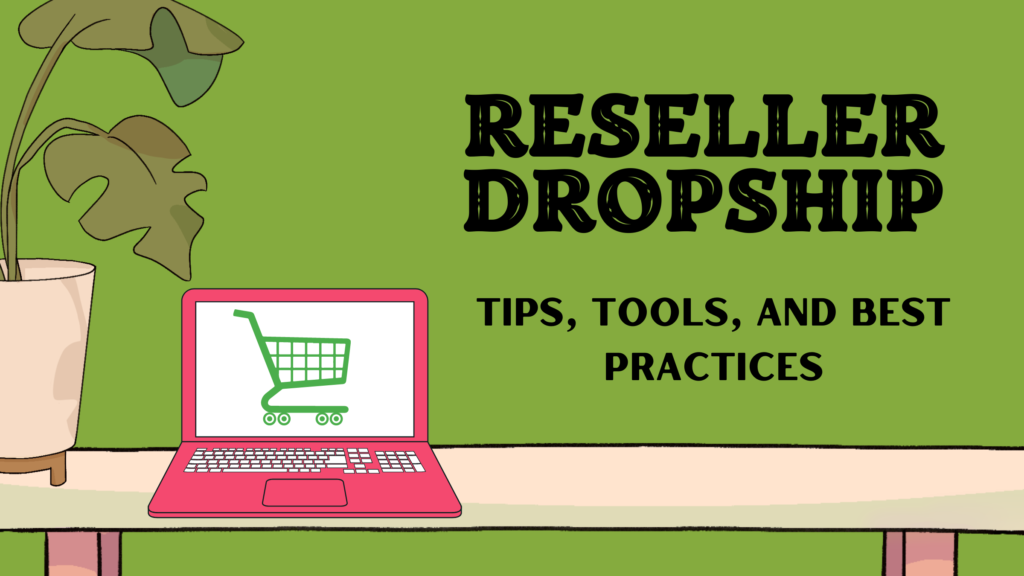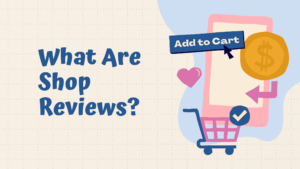Reseller dropship has become the go-to option for those wanting to enter the e-commerce industry. The forecast shows that the global dropshipping market could reach $476 billion by 2026. At first, such figures might suggest that dropshipping is a lucrative industry.
However, this also means that the industry is highly competitive, and customers are always searching for quality products at affordable prices. So, before starting, we must think about how to get ahead of the competition.
Figuring out what others are doing and doing it better can help us gain a competitive advantage. In this article, we’ll talk about what dropshipping is, how to start in the reseller dropship industry, and how to use the Koala Inspector to stay ahead of the competition.
I. What is Dropshipping?
In simple terms, dropship eliminates the need for sellers to hold inventory. In this business model, the seller essentially acts as the middleman. Orders are passed on from the seller to the supplier, who delivers.
Why does it work? The dropshipping model is effective mainly because it creates a specialized system. Suppliers can focus on what they know best- inventory and shipping. Meanwhile, sellers can foster customer relations and promote products more effectively.
Holding inventory isn’t just about the cost of storage. It also needs to be maintained, tracked, and reordered regularly. A drop ship inventory eliminates this need while keeping the business running.
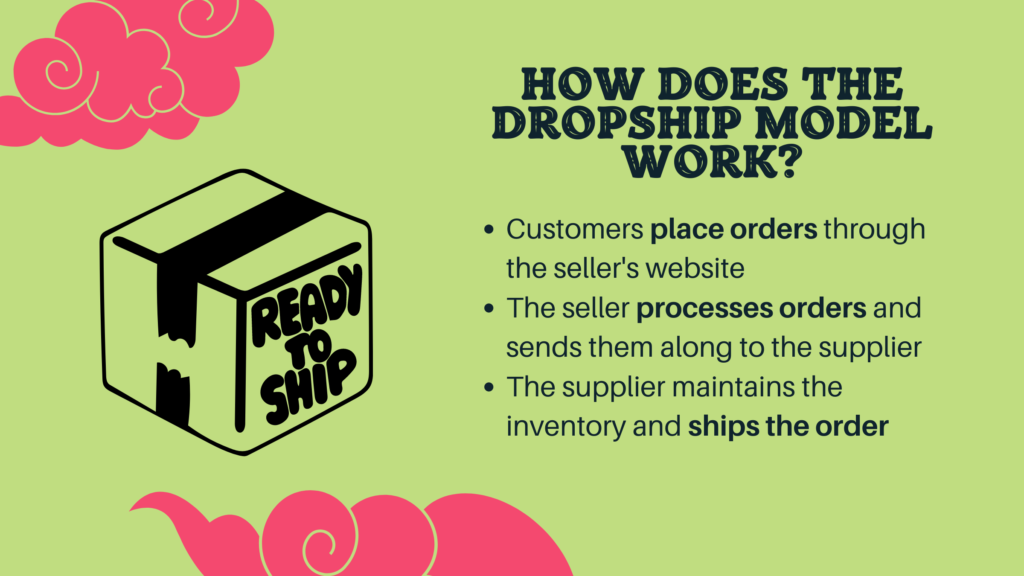
So how exactly does the dropship model work? It’s quite simple:
- Customers place orders through the seller’s website
- The seller processes orders and sends them along to the supplier
- The supplier maintains the inventory and ships the order
Because the seller does not have to deal with inventory, they can focus on other business aspects. The seller essentially promotes the product, while supply is maintained by a third party. All in all, this business model can work out for anyone looking only to handle one aspect of the business.
The real question is: Is dropshipping worth it?
-
Pros of dropshipping
The obvious advantage of a dropship business is that our startup costs will be lower. Without an inventory to invest in or renting storage space, sellers have more leftovers to invest elsewhere. This leaves us with the opportunity to focus on marketing and customer outreach.
The absence of dropship inventory also means there will be no associated costs. Maintaining and managing inventory can be a hassle and usually require additional employees. Without inventory to worry about, the business can focus on its actual strengths.
Moreover, sellers introduce great flexibility in their operations. Dropshipping businesses can operate from anywhere, even from a garage or a bedroom. All we need is an online presence and a reliable seller-supplier relationship.
In the same vein, as a seller, we can offer a lot more variety. By sourcing from multiple suppliers, customers can find many more products on one site. That kind of availability should earn us a competitive edge.
The global dropshipping market is expected to reach $243.42 billion in 2023. As a growing industry, it offers a prime opportunity for new sellers entering the market. Businesses like Amazon, Shopify, and AliExpress are all examples of successful drop ship businesses.
-
Cons of dropshipping
To get the complete picture, let’s go over the potential downside of a dropship business. With no barriers to entry and a growing industry, sellers can expect increased competition in the coming years. This means sellers will have to get creative if they want to create a competitive edge for themselves.
Moreover, as a seller, we have no control over the quality of the products being shipped. Should they not live up to the mark, the seller, not the supplier, can end up in hot waters with customers. As such, without exhaustive research, suppliers should not be engaged in the business.
Similarly, an unsatisfied customer will become hard to please. When it’s time to coordinate a return purchase, getting the ball rolling with the supplier can become hard. It becomes another issue if a customer wants a refund.
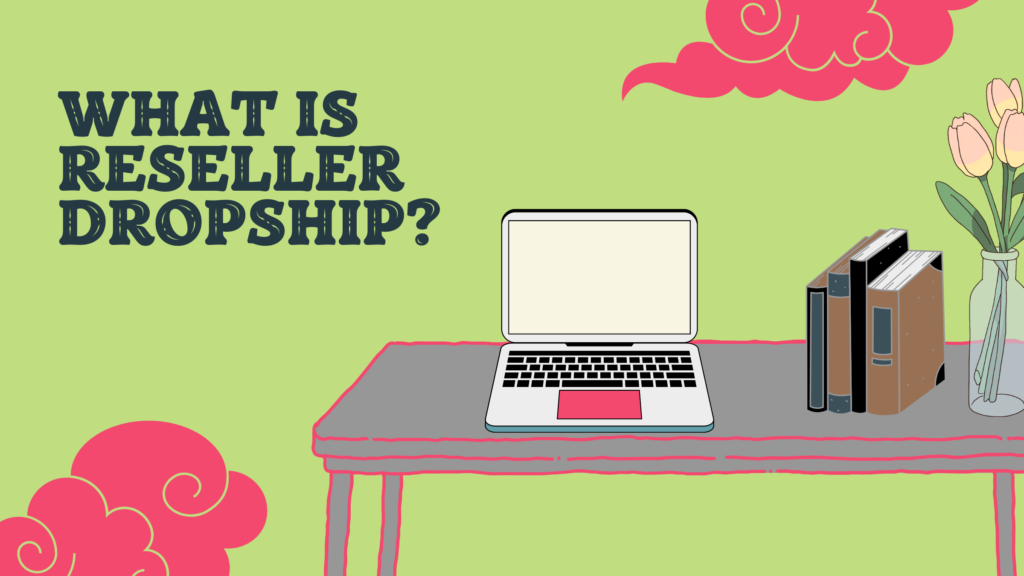
II. What is Reseller Dropship?
Dropshipping is a retail business model which can be applied in different ways. One of the most common techniques is through reseller dropship. What does that involve? Simply put, suppliers source their products from other sites, then sell through their stores.
The products are generally sourced from sites like Amazon and Shopify. From there, sellers can also review which products are the most popular and in demand. As a bonus, many product reviews can go along with the product and boost sales.
Why is this a common technique? Reseller dropship eliminates the need to do your research in finding reliable suppliers. We can choose products based on public opinion and make them available through our sites.
Since the product is already popular on Shopify, it will likely be successful on our site too. It is easy enough to check a product’s success through reviews and ratings. From there, sellers can establish their profit margins through reseller dropship.
The reseller dropship method is best for those who want to be more selective with what they sell. Reselling lets sellers pick and choose what products they want to feature on their sites. Without needing to invest in research or inventory, we can give more attention to customer relations.
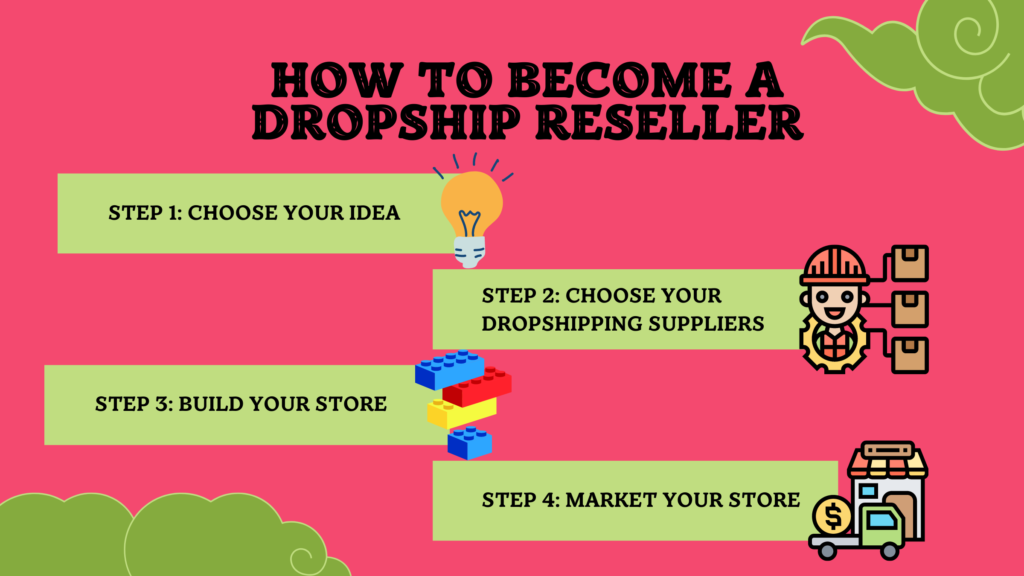
III. How to Become a Dropship Reseller
If you’ve decided to enter the reseller dropship market, the next step is to figure out how to start. Your first step is always to research and ensure this is what you want to do. Familiarize yourself with the pros and cons of reseller dropship before you start working on it.
Now let’s look at how you can become a dropship reseller.
-
Step 1: Choose your idea
As with any other business, dropshipping requires some research. You need to look into what product market you want to dropship. This also means investigating specific products, suppliers, and any market niches.
Your ideal research pattern can include existing customer reviews for products and suppliers. Of course, some hands-on research is good too. You can try the product and talk to suppliers to determine who the best fit is.
You can also use dropshipping spy tools to help identify the best options for your reseller dropship business.
Once you have an area identified, do some competitor research. Knowing how our competitors operate is the only way to gain an advantage. This should help identify unique selling points for our business.
-
Step 2: Choose your dropshipping suppliers for your Reseller Dropship store
Naturally, you want dropshipping suppliers who can provide quality products. When conducting any research, Google is our friend. As a reseller dropship, we should look at suppliers listed on sites like Shopify.
Your drop ship inventory needs to come from a reliable source. Besides product quality, you must ensure that dropshipping suppliers are efficient at their jobs. Delays on their end can result in losses for our business.
At this point, we have already determined what our drop ship inventory would look like. Now we need to ensure our dropshipping suppliers also fit the bill.
-
Step 3: Build your Reseller Dropship store
Once your dropshipping suppliers are decided, you can start building your store. As dropshipping is intended to make things simpler, building an online store should be an easy task. Our e-commerce store can be featured on platforms like Shopify, AliExpress, and Amazon.
Sites like Shopify make it much easier to establish and run an e-commerce store. As a complete platform, it is easy enough to host your site and start your business.
-
Step 4: Market your store
The final step is to ensure people know about the store. Platforms like Shopify and AliExpress make it much easier to market your site and boost sales. There are also other ways available to you to create awareness for your site.
The most common technique is ads. Google and Facebook ads tend to receive the most engagement. Research shows nearly 1 billion users message a business through Facebook every day.
These days, social media sites like Instagram are also incredibly popular. They are being increasingly used to market businesses. In your research, you should determine where most potential buyers maintain their online presence.
With this information, you will know where to focus your marketing efforts. With reseller dropshipping, this type of research is much easier. You can easily refer to the existing customer base to determine who your audience will be.
IV. The best dropshipping suppliers for Reseller Dropship
While it is important to conduct research into potential dropshipping suppliers, it doesn’t hurt to have a little guidance. Some of the key features to look into when choosing suppliers include:
- Platform presence. Platforms like Amazon, Shopify, and AliExpress are successful for a reason. They provide a great one-stop shop for sourcing a variety of products. Looking into a supplier with a certified online presence is also easier.
- Drop ship inventory. The inventory- that is, what we are looking to invest in, is an important consideration. The drop ship inventory should meet the standards you have set.
- Prices. Naturally, how much the drop ship inventory will cost you is highly relevant. We need a price that leaves sufficient room for a profit margin. This is why it is better to look around before settling on a dropshipping supplier.
The final choice is likely to depend on other factors, too—location, delivery times, and of course, your chosen drop ship inventory. You might also want to find a supplier who can offer more variety.

V. Koala Inspector Find Retailers Feature
Starting, it can be hard to determine where exactly to look to find the perfect dropshipping supplier. Extensive research requires plentiful resources to ensure you get the best quality drop ship inventory. Luckily, there are tools available now that can make the process much simpler.
The Koala Inspector is an e-commerce inspector Chrome extension that can give you insider information on Shopify stores. We can find everything from strategy, products, and pricing to customers in one click. It even shows what platform the seller is dropshipping suppliers from.
Its Find Retailers feature can help you find the right dropshipping suppliers. The feature provides insights that are not typically available with a Google search. For a reseller dropship, these insights are extremely valuable to find the right suppliers.
Moreover, it can afford sellers automated dropshipping. Because the Inspector takes care of the time-consuming tasks, sellers are free to focus on other business aspects. Using all the necessary criteria you set, the Koala Inspector can find the right fit for your business.
With the paid version, you can also create and export the information you gather. Organized in neatly arranged lists, it is easier to utilize the information to make business decisions. The Inspector is not limited to finding a supplier- it can handle many business aspects for you!
Such aspects can include determining your pricing and market strategy. When you know how your competitors operate, it becomes easier to determine what you need to do. From there, you can develop unique strategies that help you stand out.
VI. Conclusion: What is Reseller dropship?
Automated tools help make the right choice simpler by delivering necessary insights. The Koala Inspector helps detect the right supplier for reseller dropship based on the factors you determine. Whether you value pricing or delivery times, you can find optimal options through the Inspector.
Another key aspect is the drop ship inventory. With the insights the Koala Inspector provides, you can determine which supplier has what you are looking for. This cuts down the considerable time and costs we incur doing research manually.
All in all, the free Koala Inspector tool is a great resource for new reseller dropship. Its automated processes make it much easier to launch and maintain an e-commerce business. In the end, you are looking at higher profitability for less work.

